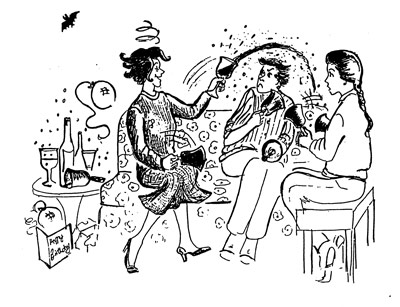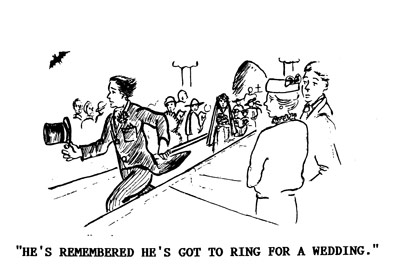Dyslexic Ringers
by Wendy Graham.
 While every one of us has certain little difficulties and foibles which affect our ability to learn, some have very definite, identifiable learning problems. One of these is dyslexia. This was only named and noted as a specific condition in 1902, although, undoubtedly, there have, since man first walked the Earth, been those who manifest dyslexic symptoms.
While every one of us has certain little difficulties and foibles which affect our ability to learn, some have very definite, identifiable learning problems. One of these is dyslexia. This was only named and noted as a specific condition in 1902, although, undoubtedly, there have, since man first walked the Earth, been those who manifest dyslexic symptoms.
Most of the research into dyslexia has been conducted in the last fifty years and clearly a great deal more will be found out about the condition which may, indeed, turn out to be a selection of related problems which currently go under the umbrella title “dyslexia”. While each dyslexic person is different, there seems to be general agreement among scientists that dyslexia is caused by slight differences in the way the brain is formed. The human brain is divided into two sections or hemispheres. Normally the left brain deals with language, number, analysis, logical reasoning and detail while the right hemisphere takes more of an overall view of situations and is concerned with spatial awareness, rhythm, intuition, emotions and artistic understanding. For almost everyone one hemisphere is dominant and, in the Western world at least, the majority of people are left-brain dominant. Strangely, perhaps, the left brain controls the right side of the body; hence, right-handedness is far more common than left-handedness. However, hemisphere dominance is far more complex than that and a fair few right-handed people have right-brain dominance (and vice-versa). Dyslexics are invariably right-brained and research suggests that they have a peculiarity or dysfunction in either the left hemisphere or the corpus callosum (section joining the left and right hemispheres). It also appears that dyslexia runs in families.
Many people are aware that the word “dyslexia” comes from Greek and means “word-blindness” and believe that an inability to read, write and spell are the signs of dyslexia. How could this affect, more than very slightly, the ability of a person to learn to be a bellringer, they may well wonder? While their beliefs are not untrue, it is, by no means, the whole truth. Only the most severe dyslexics never learn to read – I have never met one. Most learn to read efficiently and write adequately, although spelling is generally a lifelong problem. Very frequently they also have problems with maths, not so much the more advanced understanding as with the simple areas, like counting, addition and subtraction. And they usually take longer to acquire all these basic learning skills. However, these academic problems are really the symptoms of the unusual ways in which their brains process information.
Dyslexia is not uncommon. It is reckoned that around one person in ten is, to some extent, dyslexic and there are certainly plenty of dyslexic ringers, quite possibly at least one in your tower. However, because dyslexia has been studied only comparatively recently, older people, – well, most of those who are thirty-five plus – while displaying all the symptoms, are unlikely to have been formally diagnosed. And, of course, there are a great many people who are only mildly dyslexic but, nevertheless, are troubled by some of the typical problems. With a reasonable understanding of how dyslexia manifests itself, teachers can remediate many of the problems but dyslexia cannot be cured – it is for life.
So, how can the ringing teacher identify and help Dyslexic Daisy and Donald? (Incidentally, it is far more likely to be Dyslexic Donald as about three times as many boys as girls suffer from dyslexia.)
Concentration.
Neither Donald nor Daisy can help having very poor concentration. They have “butterfly” brains and are virtually unable to stop themselves from being distracted. Thoughts race through their minds and, before one is complete, another has taken its place. They find it harder than most to concentrate for any length of time so, it is even more important that the teacher helps by making every effort to keep possible distractions, such as background chatter, to a minimum.
This is closely related to:
Short-term Memory Problems.
 In the long-term Daisy and Donald have just as good – or bad –a memory as everyone else. However, in short-term situations their brains are less adept at storing what has just happened or been said in an easily retrievable place. Another thought enters the brain and the previous one is lost. The person who regularly goes off at a tangent in the middle of a conversation or who pauses and then forgets what was coming next, may well be dyslexic. So, a dyslexic ringer is more likely to lose concentration and, having done so, fail to remember what he or she was about to do and/or what he or she had just done.
In the long-term Daisy and Donald have just as good – or bad –a memory as everyone else. However, in short-term situations their brains are less adept at storing what has just happened or been said in an easily retrievable place. Another thought enters the brain and the previous one is lost. The person who regularly goes off at a tangent in the middle of a conversation or who pauses and then forgets what was coming next, may well be dyslexic. So, a dyslexic ringer is more likely to lose concentration and, having done so, fail to remember what he or she was about to do and/or what he or she had just done.
Teachers of dyslexics, in schools, myself included, often find it hard not to interrupt a student who is writing until the word and/or sentence is complete, even though a mistake has been made early on. However, it is unproductive to do so as the rest of the sentence will, almost certainly, be forgotten. The teacher of ringing should, as far as possible, resist the temptation to speak to the dyslexic learner while he or she is ringing. There is a high chance that a comment or piece of advice will break the concentration and the ringer will remember neither what has just been done nor what comes next. As far as possible, instruction and advice should be given before or after ringing and correction during may be less distracting if a gesture rather than speech is used.
It is very important that the teacher should realise that dyslexic learners will only be able to take in one, or two at most, instruction(s) at a time. A string of pieces of advice will not be remembered and will only lead to confusion and a flustered learner who feels he (or she) has failed.
Also related are:
Sequencing Problems.
Most dyslexics find spelling difficult because they cannot very accurately recall the order of letters in a word although they are quite likely to know which letters are in the word. Similarly, few dyslexics manage to learn their times tables with any certainty, nor will they remember phone numbers, nor any series of numbers or letters, in the correct order, with any ease. Sequences can be important in ringing so the teacher must be prepared to be creative in order to help confused learners. Dyslexic adults will probably have worked out their own strategies but may still welcome ideas while children are more likely to need help. Learning the order of work in a method could be a problem. For some (the kinaesthetic learners – See “Styles of Learning”) actually doing it until it comes to feel right will be the answer. Others may find sound – tunes - or visual sequences – patterns, shapes, colours – much easier to remember than such things as words and numbers. Another example of a possible difficulty might be counting places. Counting forward is far less likely to be a problem than counting backwards but a teacher could help the learner by suggestions such as singing the numbers to a suitable tune (preferably in the ringer’s head) which might suit an auditory learner or, for a visual learner, imagining a staircase or ladder, up and down, with a wide top (for the two blows which generally occur at the back) and the same number of steps as there are inside bells with the ground for the treble so the learner can imagine going slowly up to the top, then faster down the other side to the lead. (There are further ideas in “Methods to Memorise Methods”)
Poor concentration, a weak short-term memory and sequencing difficulties are the salient features of dyslexia and it is easy to see how the person with these would have trouble with spelling, not to mention certain aspects of ringing. It is also clear why they should lead to some of the other problems caused by dyslexia. Such as:
 General Disorganisation.
General Disorganisation.
For many dyslexics, especially when schooldays are over, this is their most annoying problem. Even with all the strategies they are taught or work out for themselves, most are the sort of people who are frequently late, forget meetings and practices, especially if not at the regular time, are always losing things, forget to bring promised items and often leave belongings behind them. There is no easy answer although all sorts of aids, from written lists to alarm watches, are worth trying and can help. Although it may be infuriating for both teacher and pupil, anger and annoyance will only increase anxiety and the disorganisation will be increased as well.
Directional Problems.
A difficulty knowing right from left, up from down and clockwise from anti-clockwise, especially in a hurry, is another common characteristic of dyslexia. While it is obvious why this could be a problem in the ringing room, a dyslexic ringer heading off in the wrong direction will probably only be an occasional hazard. However, teachers should be aware of this potential problem and ready to work out creative ways to help a ringer who persists in going the wrong way.
Clumsiness.
This is associated with dyspraxia rather than dyslexia but the two often go together. Dyspraxia is generally a symptom of neuro-developmental delay, a condition arising when reflexes, usually associated with babies, have never been worked through. An example is that there are those who, when they raise their head to look straight forward, cannot prevent their arms moving outward. There are specialist teachers and psychologists who give courses of remedial exercises. However, this is hardly the task of the ringing teacher. Encourage long, smooth movements and create a calm atmosphere to avoid the extra clumsiness likely to occur in a stressful situation. I suspect that a few dyspraxic people are unsuited to becoming bellringers as they may lack the rhythm needed to be safe on the end of a rope.
Lack of Confidence.
Both dyslexic adults and children are aware of their own weaknesses, are sensitive about them and can be easily distressed by what they see as unfair criticism. Diagnosed or not, they have been through an educational system which favours those who read quickly, write fluently and accurately, analyse and memorise easily. Dyslexic pupils generally bump along at the bottom of the class (or attend special classes for “thickies”) and many have been accused of laziness while working harder than their class-mates. It is no wonder low self-esteem is normal for dyslexics. Trainee dyslexic ringers may be even more nervous and unsure of themselves than others. Teachers should be aware of this and take extra care to do all the things good teachers routinely do: Offer praise as often as possible. Create a calm, happy atmosphere in the ringing room. Never ridicule a pupil for making silly mistakes or not understanding. Be patient and willing to explain a point over and over again in different ways. Do not point out anyone’s mistakes to others as a teaching aid. Remember almost everyone is trying hard to do their best. Try to reserve rebukes and annoyance for disregarding safety procedures, deliberate rudeness and genuine laziness. Remember everyone learns differently – and some even more differently than others!
The Plus Side of Dyslexia.
Contrary to what you may feel, having read thus far, all is not doom and gloom for Dyslexic Daisy and Donald. They have typical strengths as well as weaknesses. Dyslexics are usually full of ideas, brilliant in brainstorming sessions, many are gifted artistically and they can be extra intuitive when it comes to understanding other people. However, the strength that is most relevant to ringing is the ability to have a clear overview of things, especially in a 3-D sense. Many top architects are dyslexic and it is said there is an American school of architecture which will only accept dyslexic pupils. Computer programmers, plastic surgeons, film directors and motor mechanics are some of the other occupations where this 3-D overview is useful and those at the top are frequently dyslexic. It would follow that, after some struggles in the early stages of learning to ring, the dyslexic would be far better than average at knowing where every bell is in a method, understanding the consequences of each touch and might well have the ability to manipulate variations in order to produce new methods. I strongly suspect that some of the best conductors and composers are dyslexic.
Anyone wanting to know more about dyslexia would do well to contact the British Dyslexia Association (www.bdadyslexia.org.uk)
Cartoons reprinted from "Learning The Ropes", by kind permission of the author, Barbara Martin from Salisbury.
